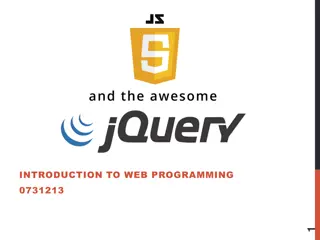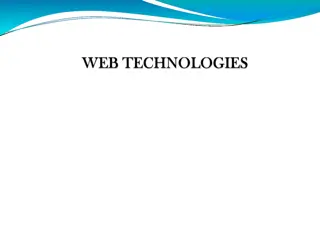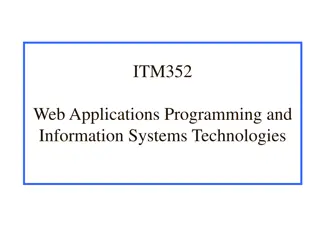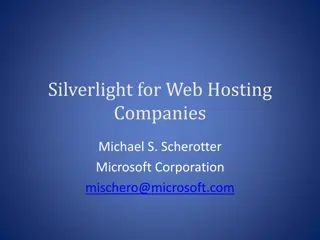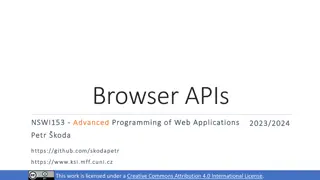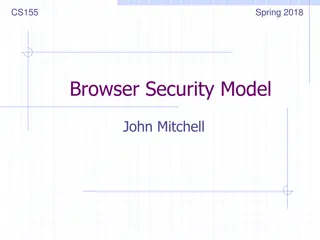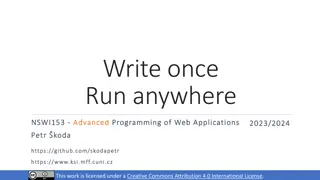
Dynamic Web Page Creation Using ASP.NET Controls
Explore the power of server-side web controls in ASP.NET for creating dynamic web pages effortlessly. Learn about the advantages of using higher-level models for server controls and the limitations of Response.Write. Dive into the world of HTML and Web Controls in ASP.NET for a more flexible and organized approach to web development.
Download Presentation

Please find below an Image/Link to download the presentation.
The content on the website is provided AS IS for your information and personal use only. It may not be sold, licensed, or shared on other websites without obtaining consent from the author. If you encounter any issues during the download, it is possible that the publisher has removed the file from their server.
You are allowed to download the files provided on this website for personal or commercial use, subject to the condition that they are used lawfully. All files are the property of their respective owners.
The content on the website is provided AS IS for your information and personal use only. It may not be sold, licensed, or shared on other websites without obtaining consent from the author.
E N D
Presentation Transcript
WEB PROGRAMMING Dr.S.Vaaheedha Kfatheen Assistant Professor Department of Computer Science Jamal Mohamed College(A) Trichy 620 020 & IT
INTRODUCTION - Use a higher-level model of server-side web controls. - These controls are created and configured as objects, and automatically provide their own HTML output. - ASP.NET allows web controls to behave like their Windows counterparts 3
A simple page Applet - This type of program, which combines user input and the program output on the same page, is used to provide popular tools on many sites. - Examples: - Taxes, health or weight indices, stock tracking utilities, retirement savings plans 4
The problem with Response.Write - Writing the result to the end of the page with the Response.Write command - This approach well for a simple page - But it encounters the number of difficulties as the program becomes more sophisticated. 7
- Lack of flexibility Very difficult to change the output - Confusing content and formatting Depending on the complexity of user interface, Response.Write may need to add new HTML tags and style attributes. - Complexity Code becomes disorganized, when add different type of functionality. 8
Server Controls - In ASP.NET, Response.Write is used to create a dynamic web page. - ASP.NET allows static HTML tags into objects. - ASP.NET provides two sets of server controls 1. HTML server controls - server based equivalents for standard HTML elements. 9
2. Web Controls - similar to the HTML server controls - provides a richer object model with a variety of properties for style and formatting and a closer parallel to Windows development. details, more events, 10
HTML Server controls - Provide an object interface for standard HTML elements Features - They generate their own interface - They retain their state - They fire events 11
Add the special attribute runat=server to each tag to transform into a server control. Add an id attribute to each control that need to interact with in code. The id attribute assigns the unique name to refer to the control in code. 12
Viewstate - If you request the HTML page, it is slightly different than the information in the .aspx file. - An additional hidden field has been added to the form. - This hidden field stores information about the state of every control in the page in a compressed and lightly encrypted form. 13
- It allows you to manipulate control properties in code and have the changes automatically persisted. - This is the key part of the web forms programming model. 14
HTML Control Classes The basic HTML Server Control classes Class name HtmlAnchor HtmlButton HtmlForm HtmlImage HTML Tag Represented <a> <button> <form> <img> 15
Important Properties Control HtmlAnchor HtmlImage & HtmlInputImage HtmlInputText HtmlSelect HtmlTextArea Most Important Properties Href, Target, Title Src, Alt, Width, Height Value Items Value 16
Events - To actually add some functionality to the existing program, to add some ASP.NET code. - Web forms are event driven - Every piece of code acts in response to a specific event. - In the above example, user clicks the submit button. 17
The currency converter program has four server controls 1. A form 2. An input text box 3. A submit button 4. A div tag named result 18
The code behind class is a typical example of an ASP.NET page: 1. it uses the imports statement 2. It defines a custom page class and control variables 3. It defines a single event handler 19
Event Handling Changes - The event handler accepts two parameters 1. .NET standard for events, and it allows your code to identify the control that sent the event and retrieve any other that may be required. 2. The event handler explicitly connects itself to the appropriate event using the Handles clause. 20
2.2 Improving the Currency Converter Adding support for multiple currencies - Add a <select> element that allows the user to choose the destination currency. - To reduce the amount of HTML programming, no actual <option> entries are added to the drop-down list in the .aspx.file. 21
Interesting facts about this code - Specify MyBase to handle a page event - Use the items property with a list control - Check for postbacks. 22
Adding Linked images - To display a currency conversion rate graph, the program need an additional button and image control. <input type= submit value= Show Graph id= ShowGraph <img id = Graph runat= server > - In the currency converter program, there are three picture files - pic0.png - pic1.png - pic2.png 23
Setting Styles - In addition to a limited set of properties, each HTML control also provides access to the CSS style attributes through a collection in the Style property. - To use this collection, need to specify the name of the CSS style attribute ControlName.Style( AttributeName )= Attribute Value 24
2.3 A deeper look at HTML control classes - Related classes in the .NET framework use inheritance to share functionality. - For eg., every HTML control inherits from the base HtmlControl, which provides some essential features every HTML server control uses. - HTML server controls generally provide properties that closely match their tag attributes. - One of the two possible events - ServerClick - ServerChange 25
HTML Control Events - The ServerClick is simply a click that is processed on the server side. - It s provided by most button controls, and it allows your code to take immediate action. - This action might override the expected behavior. 27
- The ServerChange event responds when a change has been made to a text or selection control. - This event is not as useful as it appears because it doesn t occur until the page is posted back. - At this point, the ServerChange event occurs for all changed controls, followed by the appropriate ServerClick. 28
EVENT ServerClick ServerChange CONTROLS THAT PROVIDE IT HtmlAnchor, HtmlButton, HtmlForm, HtmlInputButton, HtmlInputImage HtmlInputText, HtmlInputCheckBox, HtmlInputRadioButton, HtmlInputHidden, HtmlSelect, HtmlTextArea 29
Advanced events with the HtmlInputImage Control - There is only one HTML server control that sends additional information: - HtmlInputImage Control - It sends a special ImageClickEventArgs object that provides X and Y properties representing the location where the image was clicked. 30
Privage Sub ImgButton_ServerClick(sender As Object, _ e As ImageClickEventArgs) Handles ImgButton.ServerClick. 31
The HtmlControl Base Class - Every HTML control inherits from the base class HtmlControl. - This relationship means that every HTML control will support a basic set of properties and features. 33
Property Attributes Controls Disabled Provides a collection of all the tag attributes and their values. Provides a collection of all the controls contained inside the current control. Set this is true to disable the control. Description 34
EnableViewState Page Set this to false to disable the automatic state management for this control. Provides a reference to the web page that contains this control as a System.Web.UI.Page object. 35
Parent Style TagName Visible Provides a reference to the control that contains this control. Provides a collection of CSS style properties that can be used to format the control. Indicates the name of the underlying HTML element. When set to false, the control will be hidden and will not be rendered to the final HTML page that is sent to the client. 36
The HtmlContainerControl Class - Any HTML control that requires a closing tag also inherits from the HTMLcontainer contrl. - For example, elements such as <a>, <form> and <div> always use a closing tag. - While <img> and <input> can be used as single tags. - Thus, the HtmlAnchor, HtmlForm, HtmlGeneric control classes inherit from HtmlContainerControl, while HtmlImage and HtmlInput do not. 37
Property InnerHtml The HTML content between the opening and closing tags of the control. Special characters that are set through this property will not be converted to the equivalent Html entities. Description 38
InnerText The text content between the opening and closing tags of the control. Special characters will be automatically converted to Html entities. 39
The HtmlInputControl Class - This control defitnes some properties that are common to all the HTML controls based on the <input> tag, including the <input type= text >, <input type= submit > and <input type= file > 40
Property Type Value Description Provides the type of input control. For eg., a control based on <input type= file > would return file for the type property. Returns the contents of the control as a string. 41
2.4 The Page Class - Every web page is a custom class that inherits from the System.Web.UI.PageControl. - By inheriting from this class, your page class acquires a number of properties that your code can use. - These include properties for enabling caching, validation, and tracing. 42
Property Application and Session Cache Controls Description These collections are used to hold state information on the server To store objects for reuse in other pages or for other clients. Provides a collection of all the controls contained on the web page. 43
Property EnableViewState Description When set to false, ensuring that no controls will maintain state informations. 44
List controls - The simple list controls (ListBox, DropDrownList, CheckBox and RadioButton) are extremely easy to use. - List controls provide an additional SelectedItem property, which allows your code to retrieve the ListItem object that represents the selected item. 46
- ListItem object provides three important properties: - Text - Value - Selected Code to retrieve the selected ListItem object from an HtmlSelect control Dim Item As ListItem Item = Currency.Items(Currency.SelectedIndex) 47
- With the web control, this can be simplified with a clearer syntax: Dim Item As ListItem Item = Currency.SelectedItem 48
Multiple-Select List controls - Some list controls can allow multiple selections. - This is not possible for DropDownList or RadioButtonList 49
Table Controls - Essentially the Table object contains a hierarchy of objects. - Each Table object contains one or more TableRow objects. - Each TableRow object contains one or more TableCell object, and each TableCell object contains other ASP.NET controls that display information. 50

